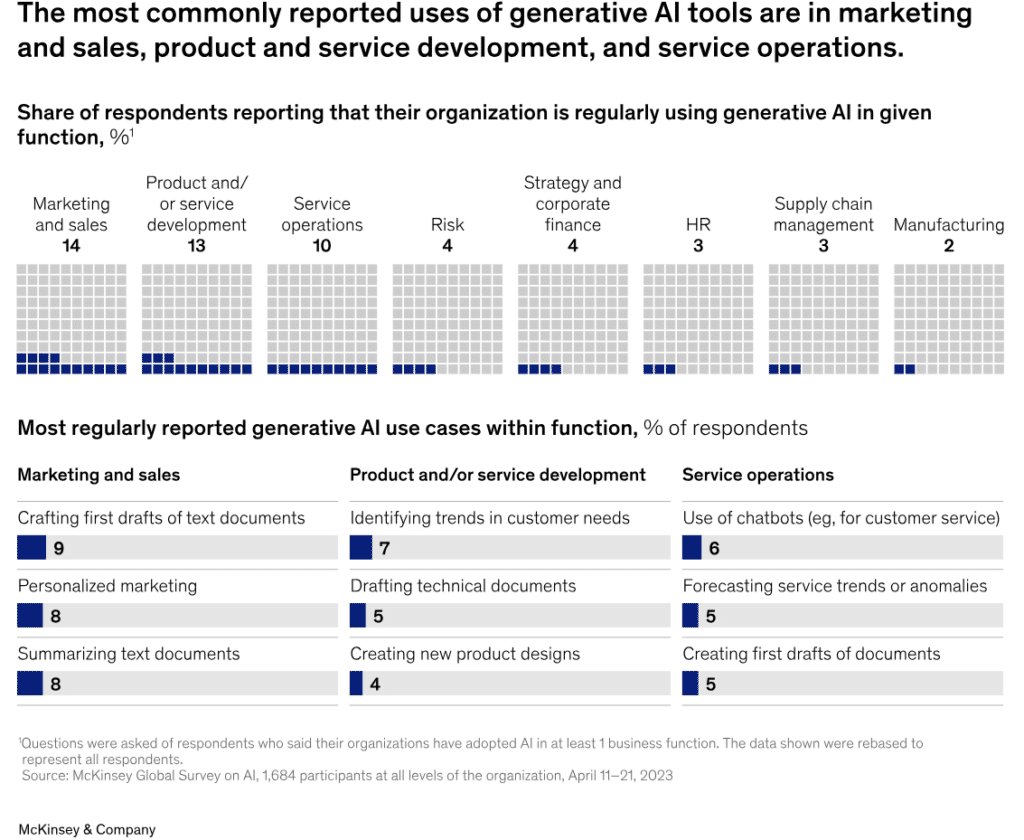Generative AI has ignited a global buzz with its boundless potential to transform how we innovate, create, and interact with technology. From creating content and realistic images to summarizing documents and composing videos, generative AI’s capabilities are reshaping the creative landscape. Owing to its remarkable capabilities, about 82% of businesses are exploring or employing generative AI to revolutionize their industry, reshaping the experience for workforce and clientele in equal measure.
Research by McKinsey indicates that 75% of professionals anticipate that over the next 3 years, Generative AI will significantly change their industry’s competitive landscape. This rapidly advancing technology holds immense potential to revolutionize content creation and consumption, offering time and resource savings while delivering high-quality output. From virtual try-on experiences to personalized healthcare solutions, Generative AI has proven to be instrumental in various applications.
This blog briefly introduces the concept of Generative AI, explains its widespread adoption, and highlights the profound importance of generative AI in the retail industry. It also sheds light on how generative AI is opening up avenues for new possibilities within the industry.
What is generative AI?
“Generative AI is a branch of Artificial Intelligence technology that focuses on creating remarkable content, such as text, photos, videos, audio, art, and more, within seconds to serve different purposes.”
In the past two years, generative AI has become more accessible due to advancements in its machine learning model, generative adversarial networks (GANs), and large language models (LLMs). These models are trained on vast amounts of data, which enables them to produce results that are nothing short of magical.
Since it’s incredibly powerful and flexible, generative AI gained traction in less than a year. One of the most significant examples is ChatGPT by OpenAI (released in late 2022), which saw its user base surge from zero to 100 million in under two months.
Despite ChatGPT’s initial breakthrough, the power of generative AI goes far beyond chatbots. Dall-e is another groundbreaking generative AI model developed by OpenAI to generate realistic and creative images from textual descriptions. The launch of Dall-e marked a significant milestone in artificial intelligence and image generation and garnered quick attention within the technology community.
Given its widespread adoption, tech giants such as Google and Microsoft have also jumped on the bandwagon with their large language models, namely Gemini and Copilot, respectively. These gen AI tools amplify human imagination and drive innovation across multiple domains.
Considering Gen AI’s capabilities, the global generative AI market is projected to hit $53.9 billion by 2028, with a robust CAGR of 32.2% during the forecast period.
Generative AI as a game-changing revolution in retail
Given the hype around this technological innovation, a McKinsey report demonstrated the surging adoption of generative AI. Within just a year of its inception, one-third of organizations across various industries are regularly using generative AI for at least one business function – marketing and sales, product and service development, and service operations.

Since generative AI has caused such a stir in marketing and sales, product development, and service operations, it is also becoming equally important for retail business leaders. The retail sector has always been a playground for emerging technologies, and generative AI, in particular, is creating a game-changing impact for retailers and consumers alike. From crafting personalized marketing campaigns to reshaping customer experiences and revolutionizing supply chain management, its influence permeates every aspect of the retail landscape.
A recent CEO survey reveals that industry leaders are increasingly turning to AI technologies to drive revenue growth. According to this survey, 42 percent of retail CEOs are prioritizing the implementation of AI technologies such as Gen AI, ML, and Deep Learning to achieve tangible results over the next three years. Currently, 40 percent of retailers and brands worldwide are experimenting with generative AI, with 21 percent already investing in it.
While Generative AI’s influence on the retail industry’s profitability is currently in its early stages, a report forecasts that by 2029, it will constitute 78% of the overall financial impact and eventually become the driving force behind the industry’s growth.
With the speed at which generative AI is developing in retail, many leading retailers are increasingly investing in adopting this advanced technology to remain competitive. Macy’s, for example, uses AI-driven shopping assistants to enhance customer experiences, enabling shoppers to receive automatic responses to inquiries regarding product availability and location.
Another notable example of retail generative AI solutions is Sephora’s virtual assistant. This virtual assistant utilizes advanced algorithms to help with personalized consultations and provides an online “in-store” shopping experience, increasing shopper’s engagement with the brand.
The revenue potential of generative AI in retail is enormous, with projections suggesting it could contribute $400-$660 billion annually to the industry. Another research suggests that about 96% of retail executives are extremely inspired by this groundbreaking technology and the immense value it brings to the business in terms of productivity, time, and cost savings, besides significantly enhancing the overall customer experience.












